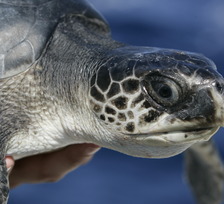What’s the secret to raising money for your science by crowdfunding? The secret is that there is no secret.

Just ask Lindsey Peavey. She’s a doctoral student at the University of California, Santa Barbara and she is taking part in the #SciFund Challenge. Her project, Turtles in the Deep, is doing wonderfully well. As of this writing, nine days after #SciFund projects went live, she has reached 80% of her $2,500 target. How did she do it? I spoke with her yesterday and this is what I learned.
Lindsey’s research and her #SciFund project focus on the fate of the threatened olive ridley sea turtle in the Pacific Ocean. From the beginning, she designed her project so that it would connect with a general audience. And she could put very specific faces on part of that audience: her family in Maine, far from the Pacific and the olive ridley. Could she connect her family (and lots of people like them) to a place they might never go and to a species they might never see? If you check out Lindsey’s project, you’ll see that she more than succeeded in crafting a message that is personal, easy to understand, and extremely relatable, regardless of where you are.
The most compelling part of Lindsey’s #SciFund project, in her opinion, is her video. And she did have a little experience with video editing, having occasionally used iMovie to edit video for family and for class projects.
But Lindsey had no experience with asking people to directly support her research. But she developed a strategic plan of action, based on the advice provided on this blog (for example: here, here, here, here, here, and here). Here are the key elements of her action plan.
- Lindsey asked for a relatively small amount of money ($2,500).
- From her years of NGO work experience, Lindsey knew that matching grants were a huge motivational tool to persuade people to become contributors. She asked her advisor, Dr. Steve Gaines, if he would be willing to help. After taking a look at a draft version of her #SciFund project, he agreed to match #SciFund contributions, dollar for dollar . This matching grant is prominently listed at the top of Lindsey’s project.
- When #SciFund projects went live on November 1st, she wrote individual e-mails to twelve of her closest friends and family members, asking them to contribute a small amount to her project. About half of them did contribute within a day, immediately giving her project initial traction.
- Lindsey then sent a mass e-mail to a much larger circle of friends, family, and colleagues, asking for their support for her campaign. What helped this effort is that Lindsey has a very large network of people to which she is connected, a network to which she makes a lot of effort to stay in touch. So, she wasn’t contacting people out of the blue.
- Lindsey also posted word of her #SciFund project to her Facebook page and on Twitter. As a newcomer to Twitter, she hasn’t been tweeting all that frequently, as she is still getting comfortable with the medium.
- Her network then spread word of Lindsey’s campaign to their own set of people they knew. For example, Lindsey’s sister posted word about Turtles in the Deep on her own Facebook page, which lead directly to many contributions from people that Lindsey did not know. And word spread even further, with multiple two-hundred dollar contributions coming from people not obviously connected to Lindsey’s network or her network’s networks.
- She has been very cautious to avoid annoying her network with repeated messages about her #SciFund project. On Facebook, she has been careful to only post notice of her project on her own page and not on others’. At the same time, as a strategy to keep her campaign in people’s minds, she has been contacting her network when milestones are reached (such as hitting the 75% funding mark).
- Lindsey has been spending a consistent amount of time – about an hour a day – on promotion and keeping up with #SciFund generally, since everything went live on November 1st.
- Possibly because of Lindsey’s promotion and messaging efforts, other media sources started to spread the word, like the popular science blog Southern Fried Science and the Dutch newspaper NRC Handelsblad.
So, there you have it. The beauty of Lindsey’s messaging and promotion strategy is that it can be emulated by other #SciFund participants. And more than 75% of #SciFund campaign time still remains, as projects close only on December 15th. Is your campaign on RocketHub truly relatable to general audiences? If you can find room for improvement, almost all of the content on #SciFund campaign pages on RocketHub can be modified. Is your promotion plan yielding results? If not, there is time to recalibrate.



6 comments on “Secrets of running a successful crowdfunding campaign”Add yours →
Comments are closed. You can not add new comments.